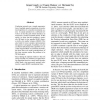Free Online Productivity Tools
i2Speak
i2Symbol
i2OCR
iTex2Img
iWeb2Print
iWeb2Shot
i2Type
iPdf2Split
iPdf2Merge
i2Bopomofo
i2Arabic
i2Style
i2Image
i2PDF
iLatex2Rtf
Sci2ools
EMNLP
2008
2008
Complexity of Finding the BLEU-optimal Hypothesis in a Confusion Network
Confusion networks are a simple representation of multiple speech recognition or translation hypotheses in a machine translation system. A typical operation on a confusion network is to find the path which minimizes or maximizes a certain evaluation metric. In this article, we show that this problem is generally NP-hard for the popular BLEU metric, as well as for smaller variants of BLEU. This also holds for more complex representations like generic word graphs. In addition, we give an efficient polynomial-time algorithm to calculate unigram BLEU on confusion networks, but show that even small generalizations of this data structure render the problem to be NP-hard again. Since finding the optimal solution is thus not always feasible, we introduce an approximating algorithm based on a multi-stack decoder, which finds a (not necessarily optimal) solution for n-gram BLEU in polynomial time.
| Added | 29 Oct 2010 |
| Updated | 29 Oct 2010 |
| Type | Conference |
| Year | 2008 |
| Where | EMNLP |
| Authors | Gregor Leusch, Evgeny Matusov, Hermann Ney |
Comments (0)

